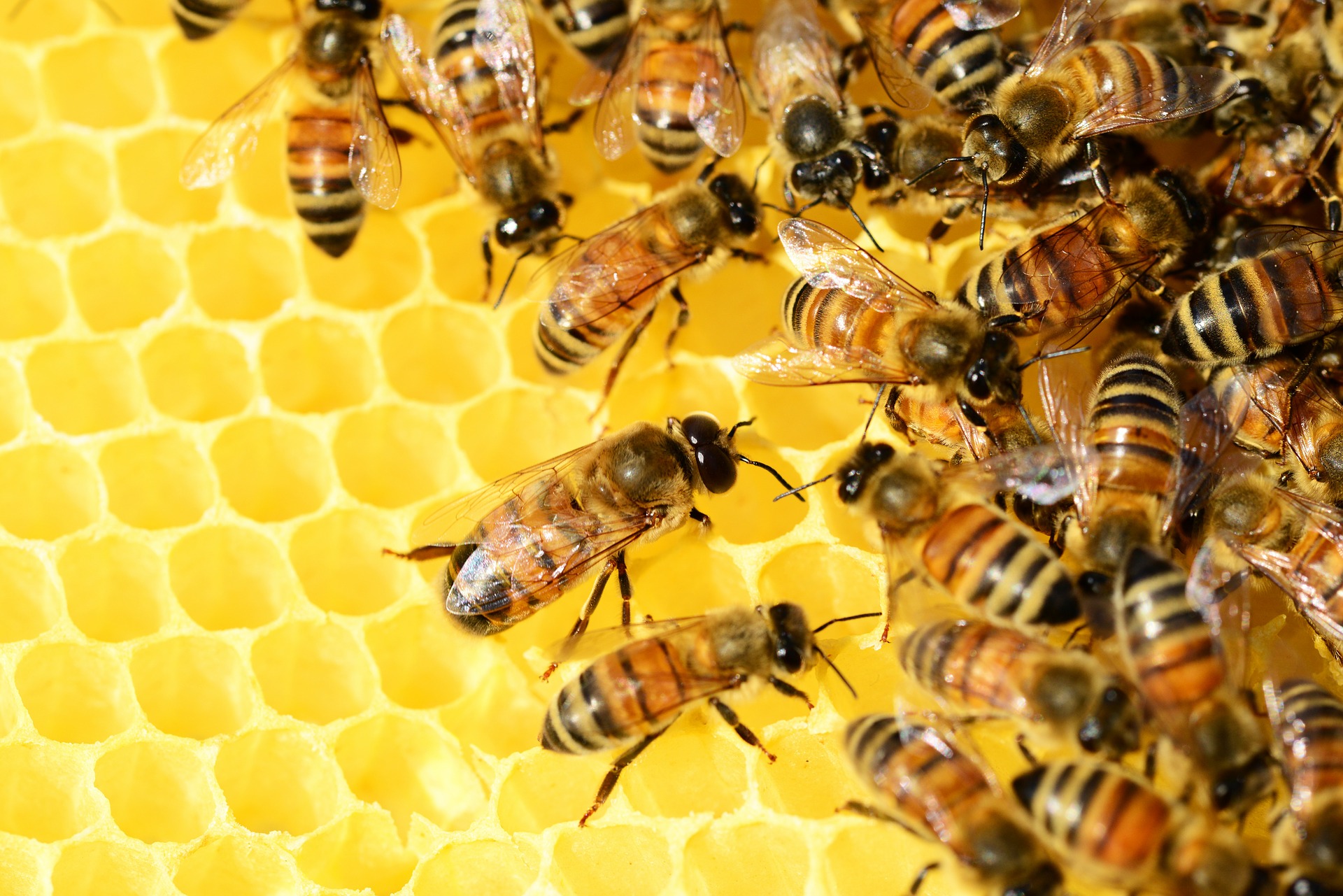In the previous articles, we discussed beekeeping in general and the value of bees as pollinators. In this article, we have a peek inside an active beehive to see who lives there and what they do.
Castes
A caste is a level of importance in the beehive, just like there are castes in many human societies. A beehive is all about social status, in short, some are created more equal than others … The queen is, well, the queen, even though she has humble beginnings. The drones are like a lot of men: fat, lazy and only interested in mating with a queen.
The workers are like womenfolk: They work from morn till night throughout their lives – and then they die.
A caste in social insects, such as bees, refer to different types of bees of the same sex but who have different bodies and do different jobs, like the worker bee and the queen. The drone is an additional caste in the hive.
All three castes have different duties, and the hive cannot survive without any one of them. It’s like they are different parts of a body, with the queen being the head who decides what the worker bees – the body – should do for the survival of the hive.
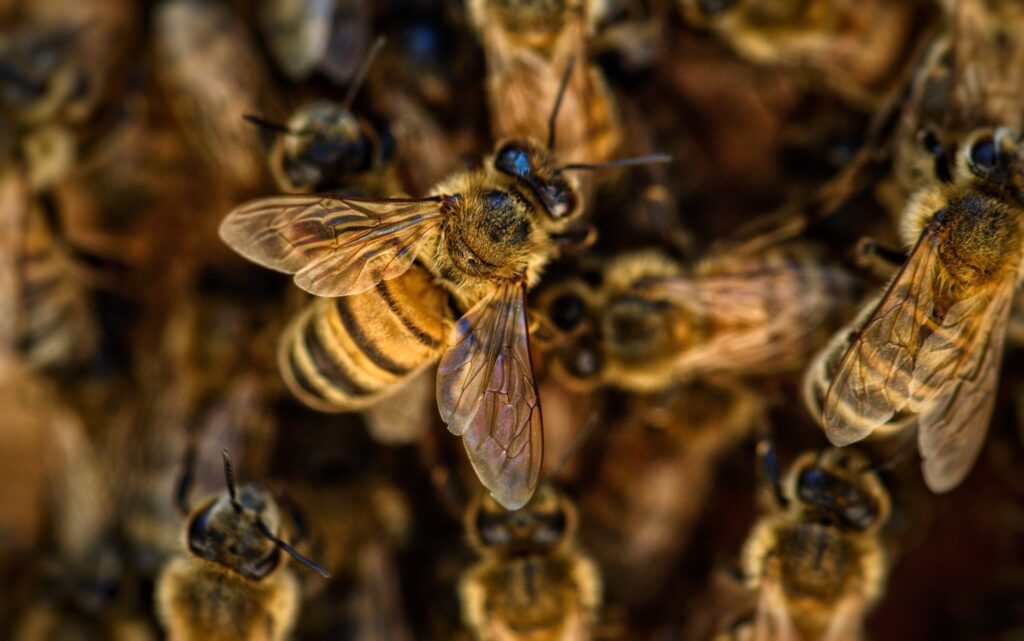
The worker bees are all females and work from dawn to dusk.
The queen
Need for a queen
Let us start with a thriving hive that is fully functional. The main duty of the queen is to lay eggs – thousands of them to replace the vast number of worker bees that die each day, whether of old age, attacks by an enemies like alien wasps, or herbicides that humans spray to get rid of harmful insects.
The queen is the brain of the hive. By releasing pheromones, a chemical substance produced and released into the environment, she controls the behaviour and physiology of all the bees in the hive. Without these pheromones, also referred to as her scent, there would be no order in any of the hive’s activities.
She would, for instance, inhibit unnecessary queen cells to be built, or prevent the workers from laying eggs. She also uses her pheromones to attract drones during her mating flight. The bees know her scent and will guard against any intruders who do not smell familiar.
Without her pheromones, the workers will mill around helplessly. A failing or dead queen must be replaced as soon as possible, therefore workers act instinctively. They choose several eggs or larvae to prepare a new queen, and so, the queen begins her life as an ordinary worker egg laid by the existing queen. Within a few days, the egg or larva is taken to a queen cell, where it will develop into a new queen with the help of the workers who feed her royal jelly that they produce with their glands.
Eventually they seal up the larvae with wax. Sixteen days later a suitable queen emerges a few days sooner than if she were just another worker bee. After escaping from her peanut-shaped cell, she is cleaned and cared for by the royal court. She is fully developed and ready to take up her duties. For the rest of her life, she will be fed royal jelly.
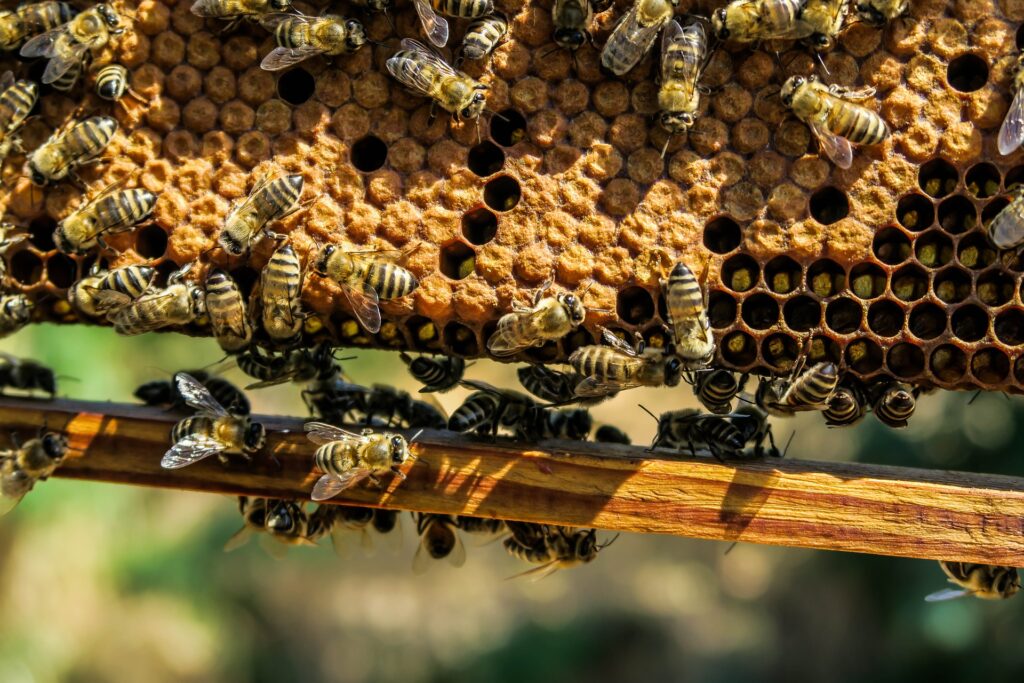
Worker bees work tirelessly to store the pollen and nectar brought to the hive by foraging bees returning from the fields.
Royal court
As the queen moves throughout the hive, she is surrounded by a group of
workers known as the royal court. Nearly every bee at the age of two weeks gets a turn to be part of the royal court. They take care of the queen by feeding her royal jelly, and touching her by rubbing their antennae over her, and so spreading her scent throughout the hive. This helps the workers – and drones – to understand what they need to do.
Types of queen cells
The reason for a new queen could be that the old queen is at the end of her life and the hive needs to replace her, or the colony plans to swarm.
Two types of cells are suitable for a queen to be: a supersedure cell or a swarm cell. The queen cell has a peanut shape, is bigger than the other cells and is built away from them. A supersedure cell is situated along the centre of a given frame and is built for a queen that will supersede the failing or recently dead queen. There can be several of these cells at a time.
The swarm cells are attached to the bottom of the brood frame. The queen that emerges from these cells will leave the colony with half of the bees inside to form a new hive. This leaves room for thousands of new bees in the existing hive, and this is the bees’ natural ability to multiply at a superfast rate. A healthy hive can swarm four or more times during the warm season.
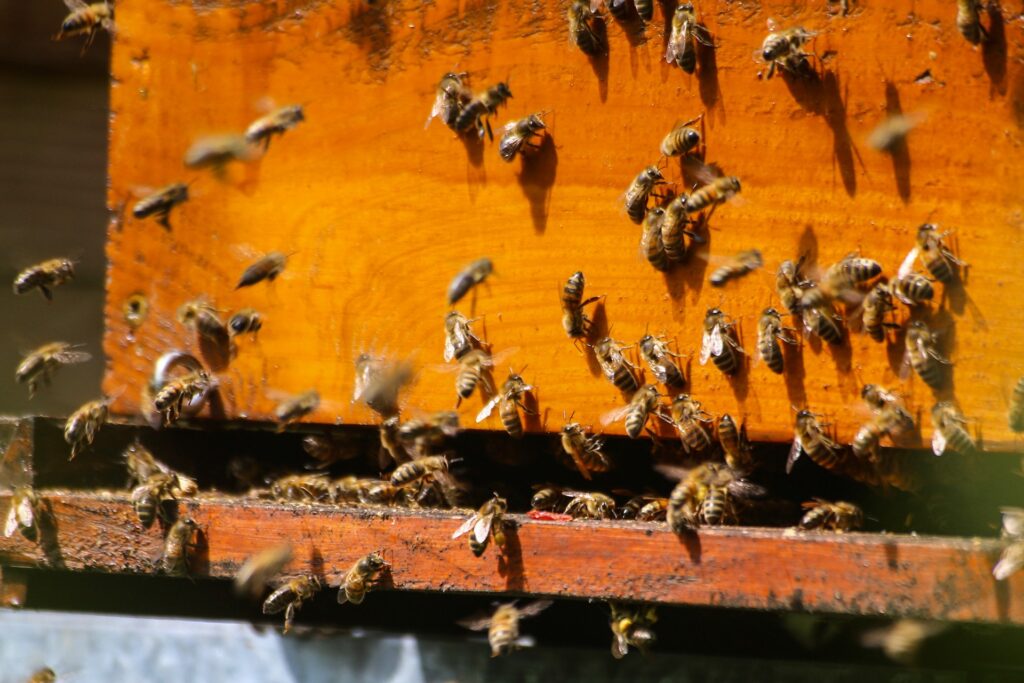
During the third week of a worker bee’s life, she undertakes short flights to strengthen her wings. Later she will fly many kilometres a day to collect pollen and nectar.
What does she look like?
The queen looks a bit like the worker – she is female after all, albeit a superior one. She is about one and a half times as large as a worker bee, with a slimmer and paler body with lighter-coloured stripes on the abdomen.
She has a bald spot behind her head on the thorax, where six legs and four wings, which appear shorter than that of the workers, are attached.
Some beekeepers mark the queen with a dot on the bald spot so that they can distinguish her more easily from the workers. Usually, the colour of the dot will indicate the year the queen started her royal duties.
The queen has a curved sting without barbs, but rarely uses it except when she must get rid of another queen.
Mating
On her first day as queen, the royal court escorts her around the hive to where worker bees are cleaning cells into which she will lay her eggs after mating. This only happens after she has killed any other queens who may not have hatched yet!
On day three of her life, the queen’s wings are strong enough to support her body, and her mating organs are developed so she is ready for mating.
She leaves the hive and flies to about ten metres above the hive. Up to twelve drones from other colonies mate with her in flight. The drone’s sex organ snaps off inside the queen so that no sperm is wasted, and the drone falls to the ground and die.
The queen may undertake up to twenty flights, but when she returns to the hive, she has enough sperm to lay fertile eggs for up to five years. The sperm is kept alive by a protein substance produced by the queen’s body.
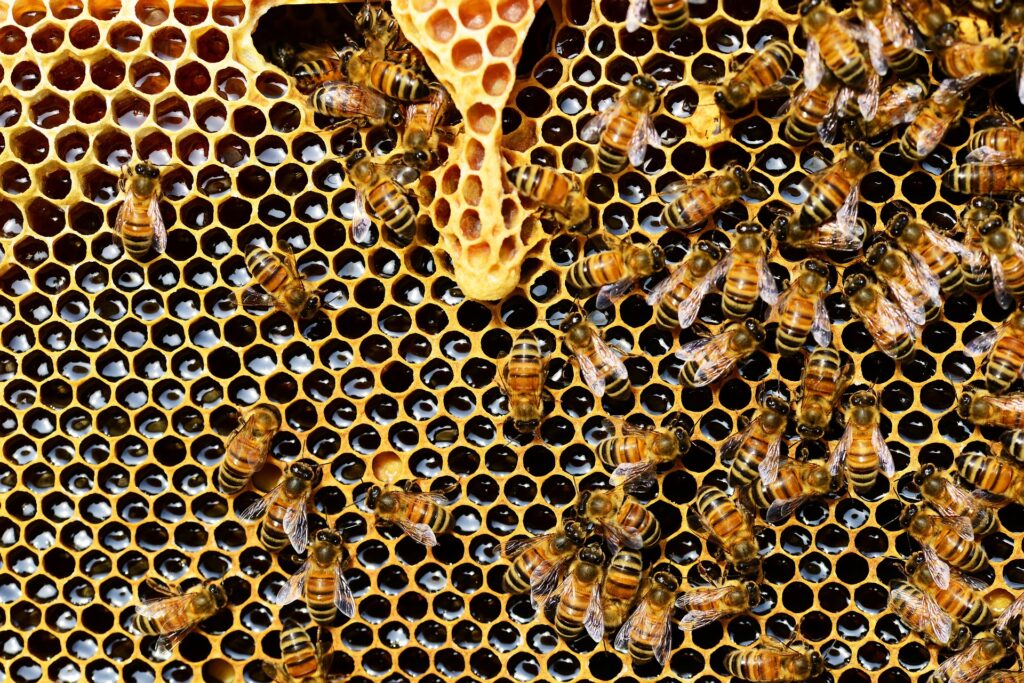
Worker bees have many tasks in the hive. They feed and cap new larvae, store the pollen and nectar, and clean the hive.
Laying eggs
Although she can lay up to 2 000 eggs per day throughout her life, she never has to mate again. This is quite astounding if one considers that a colony can exist of between 10 000 individuals in winter and up to 60 000 or more in summer.
Soon after mating the queen starts laying eggs. This is a most important job, because worker bees die at an alarming rate. She needs to lay eggs to produce worker bees to do housekeeping duties, guard the hive and collect nectar and pollen for the survival of the hive.
She inspects the cells to see if they are clean enough before putting her backside into the shallow cell to lay an egg. She produces a small bit of sticky substance in the bottom of a cell onto which the egg adheres, before moving to the next cell. She does this up to 1 500 times a day for five years, only taking short rests of five to ten minutes now and again.
The eggs and sperm are kept separately in the queen’s body and she can control which eggs must be fertilised. The workers lead the queen to the cells where she must lay eggs. If she lays an egg in a worker cell, she allows one sperm to attach to the egg to produce a female worker.
If she doesn’t attach sperm, the egg will produce a drone. The drone cells, which are bigger than the worker cells, are usually found in the corners of the hive where the pollen and nectar are stored.
Division of labour
The workers
The workers are all female. The worker is the smallest in the hive but does all the work during her lifespan. She is well-equipped for her job, which changes as she gets older – she has a honey stomach, pollen baskets, wax glands, and a barbed sting for protecting the hive against intruders.
The workers who are fresh from the uncapped cell work in complete darkness inside the hive: they feed and cap larvae, they store the pollen and nectar brought to the hive by foraging bees returning from the fields, and they clean the hive.
When they are older, they move to the hive’s entrance where they continue to receive the pollen and nectar from returning field bees, do guard duty, and cool the hive by fanning their wings for ventilation.
During the third week of the worker bee’s life, she undertakes short flights to strengthen her wings and to orientate herself to the location of the hive. When she starts foraging, she flies many kilometres a day and visits thousands of flowers to collect pollen and nectar. By doing so, she will pollinate fruit and nut trees, vegetables, oil producing plants and grains that form part of our diet.
During the roughly two weeks that she spends foraging, she will fly more than 650 km, wearing out her wings until she can fly no more. When she is about five weeks old, she will merely walk away from the hive to die a lonely death.
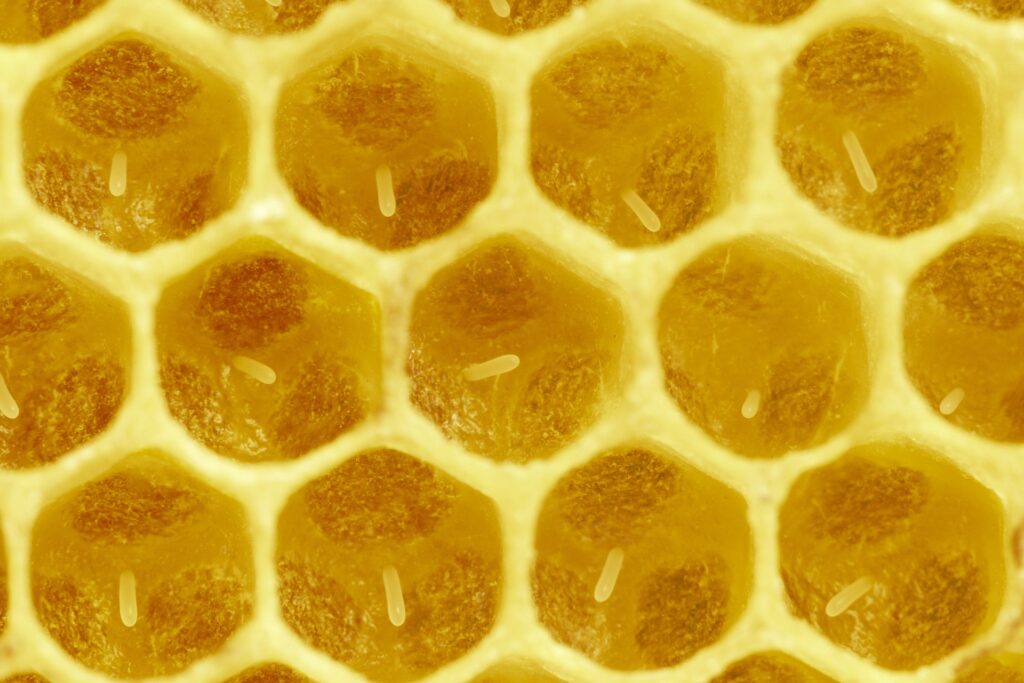
New larvae in cells.
The drone
The drones are the only males in the hive, and usually there are a few hundred of them. Their hairy bodies are larger and more square-shaped than the workers. They do not have stings, so they are no good helping to protect the hive.
Their only purpose is to ensure genetic variability of the hive by mating with a virgin queen of their own and other hives. Besides that, they are tolerated for emergency mating duties should something happen to the queen.
They usually live between 21 and 32 days before they are kicked out. In autumn, the worker bees pick them out and literally throw them out of the hive. If they try to return, the guard bees – also females – don’t allow them. Dejected, they try to find another virgin queen to mate with, or just die.
References
Caste Differentiation: The Queen, the Worker & the Drone. (n.d.) BeeWare http://www.practicalbeekeeping.com
Anderson, R.H., Buys, B., Johannsmeier, M. F. (2014). Byeboerdery in Suid-Afrika. Department van Landbou-tegniese Dienste Bulletin no. 394, 1978. Hersiene uitgawe.

